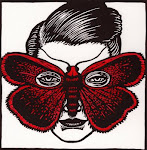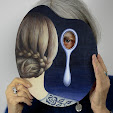The informal Q&A hello, who are you? is a regular feature of the zine. Interviewees are presented with a set list of questions, several of them deceptively playful. The questions were not only fun to answer, but potentially reveal far more facets of the subject than those that form the basis for many scholarly articles - not to mention the tediously dry, standardised information found in the average artist’s biography.
The summer edition of P. T. Peregrin’s Morse Code for Beginners was recently published. It retails for $15.00 plus postage and is available exclusively from Playing in the Attic. Incidentally, the shop is also a stockist of selected Moth Woman Press publications. If distance is an issue, you can visit Playing in the Attic on Facebook HERE and on Instagram HERE.
Pictured top are the front cover of the zine (with artwork by Trudy McLauchlan), followed by the illustrated pages of my responses to hello, who are you? Click on the image for a considerably enlarged view.
Full text of the Q&A is directly below.
hello, who are you?
Deborah Klein
Tell us a bit about yourself
I grew up in St. Kilda, not far from the beach and Luna Park. My childhood memories are bittersweet, but there’s no denying that my home town had an enduring influence on my later work. Travel was always in my blood, however, and in 1973 I flew to London, where I lived for the remainder of the decade. London was an ideal base for further travel, to Europe and other parts of the UK. It was a tremendously formative period. I was able to view artworks I had only ever seen in books and discovered artists whose works weren’t widely known in Australia, at least, not then. Film has also had a significant influence on my work - I’ve been a cineaste since my early teens - and the British Film Institute was one of my favourite haunts.
At that stage of my life, I was largely self-taught as an artist. After my return to Australia I enrolled in art school at Chisholm Institute (now Monash University). Initially I majored in painting, but switched to a printmaking major. Subsequently I gained a couple of higher degrees and for several years, starting in 2003, was a sessional lecturer in the drawing and printmaking departments at RMIT
I’ve been exhibiting since 1987. Nowadays I’m a full-time artist, working between painting, drawing, printmaking and book art.
For 20 years, my partner and I lived in inner city Melbourne. In 2011 we began dividing our time between Melbourne and Ballarat before moving permanently to the latter at the end of last year. It’s the best move we ever made.
What one piece of advice would you give to your younger self?
I’d advise myself to have greater self-confidence and repeat often.
Who or what inspires you?
My partner, Shane Jones, who is also a painter. We have similar taste in film, music, theatre and the visual arts, all of which enrich our lives. I’ve learned a great deal from him, both as an artist and individual. His work is technically astonishing, he’s patient, kind, generous, dedicated, disciplined, enthusiastic, endlessly curious and not afraid to follow his own path.
What puts you in the mood to create?
A subject that engages me, something that often originates from travel. Women’s absence from history is the thread connecting much of my work and intricately coiffed human hair is its dominant motif. In British museums I first discovered Elizabethan and Jacobean portraits, including portrait miniatures, and the finely wrought hair work found in sentimental and mourning jewellery that set my work on its current path.
Which six people would you invite to a dinner party?
I’m blessed to have some wonderful friends and couldn’t possibly narrow the guest list down to six. Instead, I’ll take the fantasy route, although I could still have added twice the number. Orson Welles, Dorothy Parker, Gloria Steinem, Elaine Stritch, Mary Shelley and Tennessee Williams should ensure some lively conversations.
Who would you dress as to attend a costume ball?
The Bride of Frankenstein, as portrayed in the 1935 film by the great Elsa Lanchester.
When did you know you were a creative little beast?
I can’t remember the exact year. I was still in primary school, possibly even kindergarten!
What is your current favourite medium to create with?
There are two - acrylic on linen and pigmented drawing inks on Khadi, a handmade rag paper from India.
What does your artistic future hold?
More work - it’s what keeps me going. Beyond that, I can only speak for the immediate future. I’m fortunate that most of last year’s projects, including three exhibitions and a residency, have been rescheduled for 2021.
What is your favourite possession?
It would be impossible to single just one of them out. Instead, I nominate an object that is technically none of those things - the digital projector my partner and I purchased at the start of the first lockdown. Our Art Deco house came with a cinema room on the first floor. We have a huge collection of films and throughout the COVID-19 lockdowns our projector opened a magic portal through which we could travel to other worlds.
What are you reading at the moment?
The Door and Other Uncanny Tales by Dmetri Kakmi. Dmetri is a marvellous writer, as well as being a close friend. The compelling novella-length title story was inspired by Shane’s full-scale painting of a door that now hangs next to the screen in our home cinema. It’s so convincing that Dmetri once tried to open it. The Door is a ghost story with an autobiographical core, but Dmetri has also drawn from elements of my life and Shane’s so it holds great personal significance for us both.
From P.T. Peregrin’s Morse Code for Beginners (Quarterly zine, summer edition)
Edited by Trudy McLauchlan and Prudence McBeth, a Teepee Publication, 2021











+copy+2.JPG)






